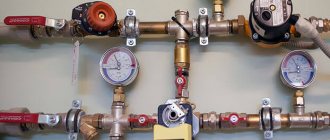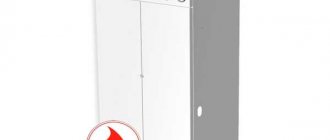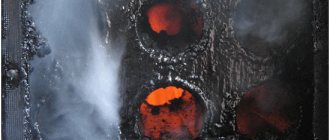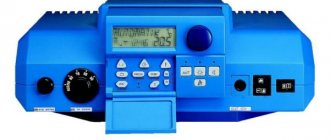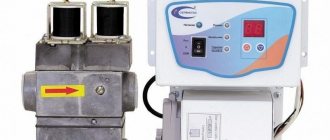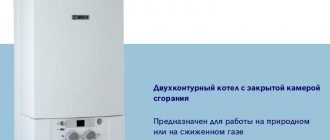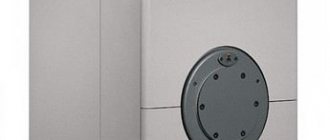If we compare the heating system with a living organism, then the boiler with the accompanying piping devices is a kind of “heart”. It is from here that the heated coolant is sent for circulation through “arteries” - supply pipes. And here, through the “veins” - the return pipes, the cooled one returns to replenish its thermal energy potential and again go along the circuit. It is clear that the capabilities of this “heart” must be adequate to the power of the entire “organism”. That is, the heating system must cope with its tasks without “suffocating” from the lack of generated heat. But excessive excess thermal energy is absolutely not useful for it.
Setting up a gas boiler yourself
What does this mean? First of all, about the fact that even when choosing a boiler, it is necessary to calculate the required power to fully provide the system with heat in the most unfavorable conditions, at the peak of winter cold. But that is not all. Many modern boilers are capable of operating over a very wide power range. Therefore, you need to be able to organize the operation of the heat generator so that it operates in optimal conditions and with minimal consumption of energy and its motor resource.
Expert opinion: Afanasyev E.V.
Chief editor of the Stroyday.ru project. Engineer.
Such adjustments are usually considered the prerogative of local gas industry specialists. But, probably, the inquisitive owner of a house or apartment will be interested in learning how to set up a gas boiler with his own hands.
Factors affecting boiler operation
They are:
- Design. The equipment may have 1 or 2 circuits. It can be mounted on a wall or on the floor.
- Normative and actual efficiency.
- Proper heating arrangement. The power of the equipment is comparable to the area that needs to be heated.
- Technical conditions of the boiler.
- Gas quality.
Question about the design.
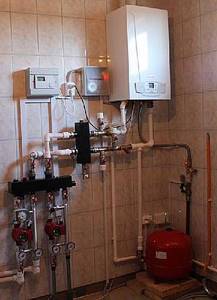
The device may have 1 or 2 circuits. The first option is complemented by an indirect heating boiler. The second one already has everything you need. And the key mode in it is the provision of hot water. When water is supplied, heating ends.
Models mounted on the wall have less power than those placed on the floor. And they can heat a maximum of 300 sq.m. If your living space is larger, you will need a floor-mounted unit.
P.2 efficiency factors.
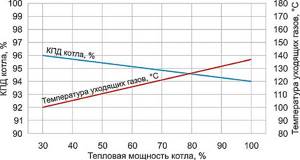
The document for each boiler reflects the standard parameter: 92-95%. For condensation modifications it is approximately 108%. But the actual parameter is usually 9-10% lower. It decreases even more due to heat losses. Their list:
- Physical underburning. The reason is excess air in the apparatus when gas is burned, and the temperature of the exhaust gases. The larger they are, the more modest the efficiency of the boiler.
- Chemical underburning. What is important here is the volume of CO2 oxide produced when carbon is burned. Heat is lost through the walls of the apparatus.
Methods for increasing the actual efficiency of a boiler:
- Removing soot from pipelines.
- Elimination of scale from the water circuit.
- Limit chimney draft.
- Adjust the position of the blower door so that the coolant reaches its maximum temperature.
- Removing soot from the combustion compartment.
- Installation of a coaxial chimney.
P.3 Questions about heating. As already noted, the power of the device necessarily correlates with the heating area. A competent calculation is needed. The specifics of the structure and potential heat losses are taken into account. It is better to entrust the calculation to a professional.
If the house is built according to building codes, the formula works: 100 W per 1 sq.m. This results in a table like this:
| Area (sq.m.) | Power. | ||
| Minimum | Maximum | Minimum | Maximum |
| 60 | 200 | 25 | |
| 200 | 300 | 25 | 35 |
| 300 | 600 | 35 | 60 |
| 600 | 1200 | 60 | 100 |
It is better to purchase foreign-made boilers. Also in advanced versions there are many useful options that help you achieve the optimal mode. One way or another, the optimal power of the device is in the spectrum of 70-75% of the highest value.
The optimal operating mode of a gas boiler to save gas is achieved by eliminating clocking. That is, you need to set the gas supply to the lowest value. The attached instructions will help with this.
Adjusting the gas pressure in front of the burner in DHW mode
Setting the maximum gas pressure:
On the boiler display we set the maximum hot water heating temperature to 60 °C.
We remove the lid from the boiler and provide access to the gas valve and the ability to observe the height of the flame in the burner. I recommend connecting a U-shaped pressure gauge to the measuring connection (1) of the gas valve.
Remove the cover of the adjusting device on the gas valve (item 4 in the figure). Mark the original position of the adjusting devices - nuts and screws - relative to the body with a colored marker, if you need to restore their position.
Turn on the DHW mode on the boiler by opening the hot water tap to full flow with maximum water flow (horn in the bathroom 6 l/min).
Adjust (reduce) the gas pressure in front of the burner using the maximum gas pressure adjustment nut (item 2). When turning to the right, the gas supply increases, and when turning to the left, it decreases. Visually observe the height of the flame in the boiler burner. The purpose of the adjustment is to find the limit where further rotation of the adjusting nut leads to a decrease in the flame height in the burner, a decrease in the temperature of hot water from the tap and a decrease in gas pressure at the measuring fitting (1). Leave the nut in a position close to the found boundary.
As a result, the maximum power of the boiler will become less, and the right boundary of the working zone in the diagram will shift to the left, to the point with coordinates, for our example, 60 °C and 6 l/min.
Setting the minimum gas pressure in front of the burner:
On the boiler display, set the hot water temperature to 52 °C. (read about setting the DHW temperature above)
At the gas valve, disconnect the modulator power cable. The boiler will switch to minimum power mode.
Turn on the DHW mode on the boiler by opening to the minimum flow with a water flow rate sufficient to turn on the boiler burner.
Adjust (reduce) the gas pressure in front of the burner using the minimum gas pressure adjustment screw (item 3). When turning to the right, the gas supply increases, and when turning to the left, it decreases. Visually observe the height of the flame in the boiler burner. The purpose of the adjustment is to reduce the gas supply to the burner (flame height) so that the burner operates continuously and the temperature of the hot water from the tap remains constant, the boiler does not cycle.
As a result, the minimum boiler power will become less. The left border of the working area in the diagram will shift further to the left, to a point with coordinates, for our example, 52 °C and 2 l/min.
Do not attempt to reduce the minimum gas valve outlet pressure too much. Very low gas pressure on the burner can lead to disruption of combustion stability, to the failure and extinction of the flame.
Reconnect the modulator power cable and replace the modulator cover.
Adjustment
Automatic control is provided by the heating regulator.
It includes the following parts:
- Computing and matching panel.
- Actuating device on the water supply section.
- An actuator that performs the function of mixing liquid from the returned liquid (return).
- Boost pump and sensor on the water supply line.
- Three sensors (on the return line, on the street, inside the building). There may be several of them in the room.
The regulator closes the liquid supply, thereby increasing the value between return and supply to the value specified by the sensors.
To increase the flow, there is a boost pump and a corresponding command from the regulator. The incoming flow is controlled by a "cold bypass". That is, the temperature decreases. Some of the liquid that has circulated along the circuit is sent to the supply.
Sensors collect information and transmit it to control units, resulting in a redistribution of flows that provide a rigid temperature scheme for the heating system.
Sometimes, a computing device is used that combines hot water and heating regulators.
The hot water regulator has a simpler control scheme. The hot water sensor regulates the flow of water with a stable value of 50°C.
Advantages of the regulator:
- The temperature scheme is strictly maintained.
- Elimination of overheating of the liquid.
- Fuel and energy efficiency.
- The consumer, regardless of the distance, receives heat equally.
Table with temperature graph
The operating mode of boilers depends on the environmental weather.
If we take various objects, for example, a factory building, a multi-storey building and a private house, they will all have an individual thermal diagram.
In the table we show the temperature diagram of the dependence of residential buildings on outside air:
| Outdoor temperature | Temperature of network water in the supply pipeline | Return water temperature |
| +10 | 70 | 55 |
| +9 | 70 | 54 |
| +8 | 70 | 53 |
| +7 | 70 | 52 |
| +6 | 70 | 51 |
| +5 | 70 | 50 |
| +4 | 70 | 49 |
| +3 | 70 | 48 |
| +2 | 70 | 47 |
| +1 | 70 | 46 |
| 70 | 45 | |
| -1 | 72 | 46 |
| -2 | 74 | 47 |
| -3 | 76 | 48 |
| -4 | 79 | 49 |
| -5 | 81 | 50 |
| -6 | 84 | 51 |
| -7 | 86 | 52 |
| -8 | 89 | 53 |
| -9 | 91 | 54 |
| -10 | 93 | 55 |
| -11 | 96 | 56 |
| -12 | 98 | 57 |
| -13 | 100 | 58 |
| -14 | 103 | 59 |
| -15 | 105 | 60 |
| -16 | 107 | 61 |
| -17 | 110 | 62 |
| -18 | 112 | 63 |
| -19 | 114 | 64 |
| -20 | 116 | 65 |
| -21 | 119 | 66 |
| -22 | 121 | 66 |
| -23 | 123 | 67 |
| -24 | 126 | 68 |
| -25 | 128 | 69 |
| -26 | 130 | 70 |
There are certain standards that must be observed in the creation of projects for heating networks and the transportation of hot water to the consumer, where the supply of water steam must be carried out at 400°C, at a pressure of 6.3 Bar. It is recommended that the heat supply from the source be released to the consumer with values of 90/70 °C or 115/70 °C.
Regulatory requirements must be met in compliance with the approved documentation with mandatory approval from the Ministry of Construction of the country.
Link to download the chart
- 110 - for industrial premises of categories B, D and D with emissions of flammable dust and aerosols;
- 130 - for industrial premises without the release of flammable dust and aerosols.
The maximum temperature, °C, of the heating surface should be taken as follows:
- c) for low-temperature panels for radiant heating of workplaces - 60.
- d) for high-temperature radiant heating devices - 250.
- e) for building structures with built-in heating elements:
- — 26 — for floors of rooms with constant occupancy;
- — 30 — for bypass paths, benches of swimming pools;
- — 31 — for floors of premises with temporary occupancy;
- - 28, 30, 33, 36, 38 for ceilings with a room height not exceeding 2.8, 3.0, 3.5, 4 and 6 m, respectively.
What happens when hot water is turned on simultaneously at two points of intake
The scheme becomes more complicated if, while using hot water at one point of intake, it becomes necessary to turn it on at another point, for example: when the shower is turned on in the bathroom, it becomes necessary to wash your hands in the toilet washbasin. In this case:
- the rate of hot water use increases sharply, its consumption increases,
- weak pressure of hot water appears;
- the flow of cold water into the boiler increases,
- a drop in the temperature of the boiler heat exchanger leads to the fact that the water temperature at the first intake point ceases to be comfortable,
- a few seconds are required to turn on the boiler automation for heating,
- a few more seconds for both users at two points of collection to be able to use water at a comfortable temperature.
All this time, both users cannot fully use hot water. It arrives intermittently. The unproductive consumption of water, which goes uselessly into the sewer system, increases sharply.
What if one of the users turned off the water? In this case, the consumption of hot water drops sharply. A temperature jump occurs on the heater of a double-circuit gas boiler. As a result, the temperature of hot water increases sharply at the point of intake that continues to operate. The user cannot fully use the water; it goes down the drain until the automation on the boiler is activated and water at the required temperature begins to flow to the user in a stable manner.
Since such situations are repeated several times every day, the unproductive consumption of hot water increases every day. At the same time, we should not forget about the discomfort that users experience when the supply of hot water is unstable.
Setting up, adjusting the SIT gas valve
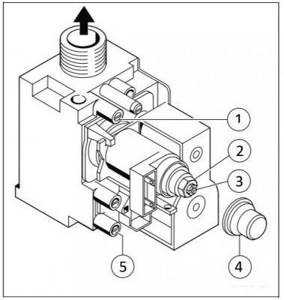
Gas valve SIT. 1 - gas pressure measuring fitting at the valve outlet, in front of the burner; 2 — adjusting nut for maximum gas pressure (flow); 3 — adjusting screw for minimum gas pressure (flow); 4 — cover of the adjusting device; 5 - gas pressure measuring fitting at the valve inlet in the gas network.
Manufacturers of double-circuit gas boilers of many brands install a gas valve from the Italian company SIT on their boilers. The maximum and minimum power settings of the boiler burner are made by rotating the gas pressure adjusting screws located on the valve body.
A U-shaped pressure gauge is attached to the measuring fitting (1) to monitor the gas pressure in front of the burner. The gas pressure value corresponding to the minimum and maximum power of the boiler is indicated in the factory instructions. For example, for a Protherm Gepard 23 MTV boiler with a minimum power of 8.5 kW, the pressure corresponds to 15 mm water column. (mm of water column). For a maximum power of 23.3 kW, the gas pressure at the fitting must be 85 mm.water column.
Heating system water temperature
- In the corner room +20°C;
- In the kitchen +18°C;
- In the bathroom +25°C;
- In corridors and stairwells +16°C;
- In the elevator +5°C;
- In the basement +4°C;
- In the attic +4°C.
It should be taken into account that these temperature standards refer to the heating season and do not apply to the rest of the time. Also, it will be useful information that hot water should be from +50°C to +70°C, according to SNiP-u 2.08.01.89 “Residential buildings”. There are several types of heating systems: Contents
- 1 With natural circulation
- 2 With forced circulation
- 3 Calculation of the optimal temperature of the heating device 3.1 Cast iron radiators
- 3.2 Aluminum radiators
- 3.3 Steel radiators
- 3.4 Warm floor
With natural circulation The coolant circulates without interruption.
Coordination of coolant and boiler temperatures
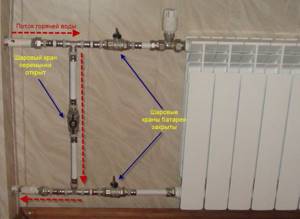
These are devices that create automatic control and adjustment of return and supply temperatures. The return temperature depends on the amount of liquid passing through it. Regulators cover the liquid supply and increase the difference between the return and supply to the level required, and the necessary indicators are installed on the sensor.
If the flow needs to be increased, a boost pump can be added to the network, which is controlled by a regulator. To reduce the heating of the supply, a “cold start” is used: that part of the liquid that has passed through the network is again transported from the return to the inlet.
The regulator redistributes the supply and return flows according to the data collected by the sensor, and ensures strict temperature standards for the heating network.
What is the difference between heating flow and return?
And so, let’s summarize the differences between supply and return in heating:
- Supply – coolant that flows through water pipes from a heat source. This could be an individual boiler or central heating of the house.
- Return water is water that, having passed through all the heating radiators, goes back to the heat source. Therefore, at the input of the system there is supply, and at the output there is return.
- It also differs in temperature. The feed is hotter than the return.
- Installation method. The water conduit that is attached to the top of the battery is the supply; the one that connects to the bottom is the return line.
After installing the heating system, it is necessary to adjust the temperature regime. This procedure must be carried out in accordance with existing standards.
Requirements for coolant temperature are set out in regulatory documents that establish the design, installation and use of engineering systems of residential and public buildings. They are described in the State Building Codes and Rules:
- DBN (V. 2.5-39 Heat networks);
- SNiP 2.04.05 “Heating, ventilation and air conditioning.”
For the calculated supply water temperature, the figure is taken that is equal to the water temperature at the outlet of the boiler, according to its passport data.
For individual heating, deciding what the coolant temperature should be should take into account the following factors:
- The beginning and end of the heating season based on the average daily outdoor temperature of +8 °C for 3 days;
- The average temperature inside heated premises of housing, communal and public importance should be 20 °C, and for industrial buildings 16 °C;
- The average design temperature must comply with the requirements of DBN V.2.2-10, DBN V.2.2.-4, DSanPiN 5.5.2.008, SP No. 3231-85.
According to SNiP 2.04.05 “Heating, ventilation and air conditioning” (clause 3.20), the coolant limit values are as follows:

Depending on external factors, the water temperature in the heating system can be from 30 to 90 °C. When heated above 90 °C, dust and paintwork begin to decompose. For these reasons, sanitary standards prohibit greater heating.
To calculate optimal indicators, special graphs and tables can be used, which define standards depending on the season:
- With an average reading outside the window of 0 °C, the supply for radiators with different wiring is set at 40 to 45 °C, and the return temperature at 35 to 38 °C;
- At -20 °C, the supply is heated from 67 to 77 °C, and the return rate should be from 53 to 55 °C;
- At -40 °C outside the window, all heating devices are set to the maximum permissible values. On the supply side it is from 95 to 105 °C, and on the return side it is 70 °C.
We control the gas pressure in the network
The gas pressure in the gas network may drop below that permissible for boiler operation. It is necessary to periodically monitor the pressure, especially in cold weather, when gas flow in the network is maximum.
At the boiler inlet, static and dynamic pressure are measured. Static pressure is when the boiler does not consume gas. Dynamic pressure is measured at maximum gas flow by the boiler.
The pressure in the gas network at the gas valve inlet is measured by connecting a U-shaped pressure gauge tube to fitting pos.5. To measure dynamic pressure, open the hot water tap to full flow.
The normal dynamic gas pressure at the gas valve inlet should be in the range of 1.3 - 2.5 kPa (13 - 25 mbar or 132 - 255 mm water column). If during measurement the dynamic pressure value falls outside the specified limits, then you must contact the gas service.
How to measure the gas inlet pressure and adjust the minimum and maximum gas pressure at the outlet of the SIT gas valve, see this video.
U-shaped pressure gauge

A simple pressure gauge for measuring a gas valve can be made from a clear plastic tube, filled with water and bent into a U shape. One end of the tube is placed over the valve fitting and the other is left open. A ruler is used to measure the difference in water levels in the branches of the tube. The measured distance will be equal to the pressure in millimeters of water column - mm.water column.
A tube with an internal diameter of 8 mm can be tightly pulled onto the gas valve fitting. For a tube of a different diameter you will have to select an adapter.
At the end of the measurements, do not forget to carefully tighten the shut-off screw on the measuring fitting and check its tightness.
Dependence of coolant temperature on outside air temperature
The specific table of the relationship between outdoor temperature and coolant depends on factors such as climate, boiler room equipment, and technical and economic indicators. Reasons for using a temperature schedule The basis for the operation of each boiler house serving residential, administrative and other buildings during the heating season is a temperature schedule, which indicates the standards for coolant indicators depending on what the actual outside temperature is.
- Drawing up a schedule makes it possible to prepare the heating for a drop in outside temperature.
- It also saves energy resources.
ATTENTION! In order to control the temperature of the coolant and have the right to recalculate due to non-compliance with the thermal regime, a heat sensor must be installed in the centralized heating system
Optimal water temperature in a gas boiler
Usually a lattice fence is installed that does not impede air circulation. Cast iron, aluminum and bimetallic devices are common. Consumer choice: cast iron or aluminum The aesthetics of cast iron radiators is the talk of the town.
They require periodic painting, since the rules require that the working surface of the heating device have a smooth surface and allow dust and dirt to be easily removed. A dirty coating forms on the rough inner surface of the sections, which reduces the heat transfer of the device. But the technical parameters of cast iron products are excellent:
- are slightly susceptible to water corrosion and can be used for more than 45 years;
- have high thermal power per section, therefore they are compact;
- are inert in heat transfer, so they smooth out temperature changes in the room well.
Another type of radiator is made of aluminum. A single-pipe heating system can be vertical or horizontal. In both cases, air pockets appear in the system. The system inlet temperature is maintained at a high temperature to warm all rooms, so the piping system must withstand high water pressure. Two-pipe heating system The principle of operation is to connect each heating device to the supply and return pipelines. The cooled coolant is sent through the return pipeline to the boiler. Additional investments will be required during installation, but there will be no air pockets in the system. Temperature standards for premises In a residential building, the temperature in corner rooms should not be lower than 20 degrees, for interior spaces the standard is 18 degrees, for showers - 25 degrees.
How is it calculated
A control method is selected, then a calculation is made
The calculated winter and reverse order of water supply, the amount of outside air, and the order at the break point of the diagram are taken into account. There are two diagrams: one of them considers only heating, the second considers heating with hot water consumption
For an example of calculation, we will use the methodological development of Roskommunenergo.
The input data for the heat generating station will be:
- Tnv – the value of outside air.
- TV - indoor air.
- T1 – coolant from the source.
- T2 – reverse flow of water.
- T3 – entrance to the building.
We will look at several heat supply options with values of 150, 130 and 115 degrees.
At the same time, at the exit they will have 70°C.
The results obtained are compiled into a single table for subsequent construction of the curve:
So, we have three different schemes that can be used as a basis. It would be more correct to calculate the diagram individually for each system. Here we examined the recommended values, without taking into account the climatic features of the region and the characteristics of the building.
To reduce energy consumption, it is enough to select a low temperature setting of 70 degrees and uniform heat distribution throughout the heating circuit will be ensured. The boiler should be taken with a power reserve so that the system load does not affect the quality operation of the unit.
Ways to reduce heat loss
The above information will help to be used to correctly calculate the coolant temperature norm and tell you how to determine situations when you need to use a regulator.
But it is important to remember that the temperature in the room is affected not only by the temperature of the coolant, street air and wind strength. The degree of insulation of the facade, doors and windows in the house should also be taken into account.
To reduce heat loss from your home, you need to worry about its maximum thermal insulation. Insulated walls, sealed doors, and metal-plastic windows will help reduce heat loss. This will also reduce heating costs.
Why does the pressure in the boiler rise? What should I do to restore work? First of all, understand the causes of the problem. In this mode, the equipment works with double load. In the best case, an error will appear on the display, and the security system will block the operation of the device. At worst, if one of the parts breaks, an explosion may occur. We will tell you how to determine the increase in pressure and reduce the pressure in this article.
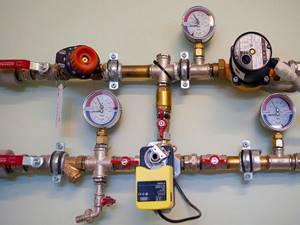
Protection against low coolant temperature in the return of a solid fuel boiler.
What will happen to a solid fuel boiler if its return temperature is below 50 °C? The answer is simple - a tarry coating will appear on the entire surface of the heat exchanger. This phenomenon will reduce the performance of your boiler, make it much more difficult to clean, and most importantly, can lead to chemical damage to the walls of the boiler heat exchanger. To prevent such a problem, it is necessary to provide appropriate equipment when installing a heating system with a solid fuel boiler.
The task is to ensure the temperature of the coolant that returns to the boiler from the heating system at a level not lower than 50 °C. It is at this temperature that the water vapor contained in the flue gases of a solid fuel boiler begins to condense on the walls of the heat exchanger (transition from a gaseous state to a liquid one). The transition temperature is called the “dew point”. The condensation temperature directly depends on the moisture content of the fuel and the amount of hydrogen and sulfur formations in the combustion products. As a result of a chemical reaction, iron sulfate is obtained - a substance useful in many industries, but not in a solid fuel boiler. Therefore, it is quite natural that manufacturers of many solid fuel boilers remove the boiler from warranty if there is no return water heating system. After all, here we are not dealing with the burning of metal at high temperatures, but with chemical reactions that no boiler steel can withstand.
The simplest solution to the problem of low return temperature is to use a thermal three-way valve (anti-condensation thermostatic mixing valve). The thermal anti-condensation valve is a thermomechanical three-way valve that ensures the admixture of coolant between the primary (boiler) circuit and the coolant from the heating system in order to achieve a fixed boiler water temperature. In essence, the valve releases the coolant that has not yet been heated in a small circle and the boiler heats itself. After reaching the set temperature, the valve automatically opens the coolant to the heating system and operates until the return temperature again drops below the set values.
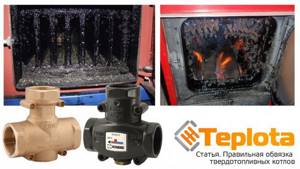
Solid fuel boiler piping - Anti-condensation valve
About the disadvantages of reducing boiler power settings
The service instructions for the Protherm Gepard 23 MTV boiler indicate its efficiency in heating mode: 93.2% at maximum thermal power (23.3 kW.) and 79.4% when operating at minimum power (8.5 kW.) Imagine how The efficiency will further decrease if this boiler has to operate with a minimum power of 4 kW. Please note that during the year, a double-circuit boiler operates most of the time in heating and hot water mode with minimal power. At least 1/4 of the spent gas will literally fly uselessly down the pipe. But clocking, as mentioned above, also reduces the efficiency of the boiler, leads to excessive consumption of water and gas, and makes using water uncomfortable.
In the comments to the article, reader Sergei writes: “The manufacturer set the minimum and maximum power of the boiler for a reason. According to you, if it were all that simple, then the manufacturer, with the help of its service representatives, would reconfigure the boilers the way you talk about it. But in these cases the manufacturer insists on fighting the pressure and not the boiler. As I understand it, this is due to the fact that changing the minimum/maximum range on the burner is dangerous, especially for the boiler. If you reduce the pressure of the gas supplied to the burner, will the flame go down, in which case will the burner be damaged over time?
And this is my answer to Sergei: “My boiler has been running for five years now. Every year in the summer I clean and inspect the burner. I don't see any signs of damage or overheating. I do the same for others. There is no protection against low gas pressure on boilers. This means that the manufacturer believes that it is not dangerous. Low pressure is dangerous for boilers with burners in which gas is pre-mixed with air and the finished mixture leaves the burner. Then yes, at low pressure, the flame can even jump inside the burner and really damage the burner. Most household boilers have a different burner. There is a danger of the flame going out or blowing out, but boilers have protection that will turn off the boiler and give an error. The choice is up to the owner - either live with the clock, or change the settings, or buy a boiler or another boiler. Manufacturers, sellers and specialists actually deceive buyers, with rare exceptions they do not inform them about the clocking of a double-circuit boiler at low water flow rates. Buyers think that there will be normal hot water at the minimum flow rate specified in the instructions, but then it turns out that this is not the case. Resetting greatly reduces the efficiency of the boiler. This information is not included in the instructions and descriptions for users. If all this was explained to customers, they would buy other boilers.”
Briefly about return and flow in the heating system
The water heating system, using a supply from the boiler, supplies heated coolant to the radiators, which are located inside the building. This makes it possible to distribute heat throughout the house. Then the coolant, that is, water or antifreeze, having passed through all available radiators, loses its temperature and is supplied back for heating.
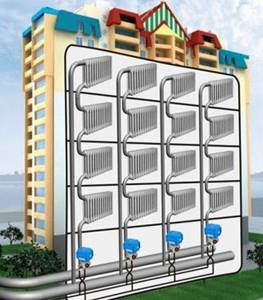
The most simple heating structure consists of a heater, two lines, an expansion tank and a set of radiators. The conduit through which heated water from the heater moves to the batteries is called the supply. And the water conduit, which is located at the bottom of the radiators, where the water loses its original temperature and returns back, will be called return. Since water expands when heated, the system provides a special tank. It solves two problems: a supply of water to saturate the system; accepts excess water, which is obtained during expansion. Water, as a heat carrier, is directed from the boiler to the radiators and back. Its flow is ensured by a pump, or natural circulation.
Supply and return are present in one and two pipe heating systems. But in the first there is no clear distribution into the supply and return pipes, and the entire pipe line is conditionally divided in half. The column that leaves the boiler is called the supply, and the column that comes out from the last radiator is called the return.
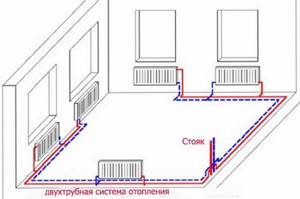
In a single-pipe line, heated water from the boiler flows sequentially from one battery to another, losing its temperature. Therefore, at the very end the batteries will be the coldest. This is the main and probably the only disadvantage of such a system.
But the single-pipe version will have more advantages: lower costs for purchasing materials are required compared to a 2-pipe; the diagram looks more attractive. It is easier to hide the pipe, and you can also lay pipes under doorways. The two-pipe system is more efficient - two fittings are installed in parallel into the system (supply and return).
This system is considered more optimal by experts. After all, its work revolves around supplying hot water through one pipe, and cooled water is discharged in the opposite direction through another pipe. In this case, the radiators are connected in parallel, which ensures uniform heating. Which of them establishes the approach must be individual, taking into account many different parameters.
There are only a few general tips to follow:
- The entire line must be completely filled with water; air is a hindrance; if the pipes are airy, the heating quality is poor.
- It is necessary to maintain a sufficiently high fluid circulation rate.
- The difference in supply and return temperatures should be about 30 degrees.
Optimal values in an individual heating system

In the case of individual heating, the concept of standards includes the heat transfer of a heating device per unit area of the room where this device is located. The thermal regime in this situation is ensured by the design features of the heating devices. It is important to ensure that the coolant in the network does not cool below 70 °C. 80 °C is considered optimal
With a gas boiler, it is easier to control heating, because manufacturers limit the ability to heat the coolant to 90 °C. Using sensors to regulate the gas supply, the heating of the coolant can be adjusted.
It is a little more difficult with solid fuel devices; they do not regulate the heating of the liquid, and can easily turn it into steam. And it is impossible to reduce the heat from coal or wood by turning the knob in such a situation. Control of heating of the coolant is quite conditional with high errors and is carried out by rotary thermostats and mechanical dampers.
Electric boilers allow you to smoothly regulate the heating of the coolant from 30 to 90 °C. They are equipped with an excellent overheat protection system.
Adjustment, adjustment of the Honeywell gas valve
Gas valve Honeywell gas boiler.
The yellow connector with wires is installed on the stepper motor. Some modern boilers, such as Protherm Gepard and Protherm Panther, have Honeywell gas valves.
The gas pressure setting at the outlet of the Honeywell gas valve is changed using a stepper motor. The gas valve stepper motor is controlled from the boiler control panel through the service menu.
—>
Let's look at setting up a gas valve with a stepper motor through the service menu using the example of gas boilers Protherm Gepard and Protherm Panther.
The influence of temperature on the properties of the coolant
In addition to the factors described above, the temperature of the water in the heating pipes affects its properties. This is the basis of the operating principle of gravity heating systems. As the heating level of water increases, it expands and circulation occurs.
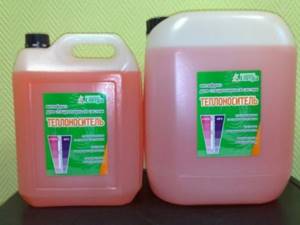
However, if antifreeze is used, exceeding the normal temperature in the radiators can lead to different results. Therefore, for heating with a coolant other than water, you should first find out the permissible heating rates. This does not apply to the temperature of central heating radiators in the apartment, since such systems do not use antifreeze-based liquids.
Antifreeze is used if there is a possibility that low temperatures will affect radiators. Unlike water, it does not begin to change from a liquid to a crystalline state when it reaches 0°C. However, if the heat supply operation exceeds the norms of the temperature table for heating to a greater extent, the following phenomena may occur:
- Foaming
. This entails an increase in the volume of coolant and, as a result, an increase in pressure. The reverse process will not be observed when the antifreeze cools; - Formation of limescale
. Antifreeze contains a certain amount of mineral components. If the heating temperature in the apartment is violated, they begin to precipitate. Over time, this will lead to clogged pipes and radiators; - Increasing the density index.
Malfunctions of the circulation pump may occur if its rated power was not designed for such situations.
Therefore, it is much easier to monitor the water temperature in the heating system of a private home than to control the degree of heating of antifreeze. In addition, when evaporating, ethylene glycol-based compounds emit gas that is harmful to humans. Currently, they are practically not used as a coolant in autonomous heat supply systems.
Causes of poor heating and methods for eliminating them
Let's consider what are the reasons why a gas boiler does not gain temperature.
The coolant temperature is incorrectly set
First you need to set the temperature on the unit correctly. This indicator may differ for different boiler models. Usually the maximum and minimum values are indicated in the instructions. Most boilers have a maximum temperature of 80ºC or 85ºC, but experts recommend setting it to no more than 60ºC. Since at high rates the water gets very hot, and scale begins to appear. Deposits cover the walls of the circuit, and its heat transfer deteriorates. This leads to the heat exchanger overheating, and the liquid does not have time to heat up enough. As a result, the heating system does not provide the optimal temperature. This problem can be solved by cleaning the heat exchanger from scale.
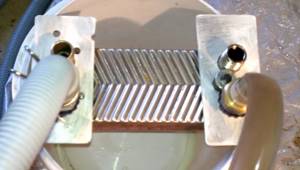
In modern models, the heating level of the coolant can be set not only by a person, but also by an outside temperature sensor. Depending on weather conditions, it automatically regulates the heating of the liquid in the circuit. If you have this device, adjust the temperature on it.
The power of the unit is incorrectly selected
When choosing a gas boiler, attention should be paid to determining the required power. If it is less or more than needed, this will lead to poor heating quality. If there is insufficient power, the unit will operate at maximum, but there will still not be enough heat.
If a gas boiler has too high a capacity, then a problem such as the unit’s clocking often arises: the gas boiler quickly gains temperature and turns off, and then turns on again after a few minutes. The room warms up poorly in this mode of operation.
This problem can be solved in several ways:
- inclusion of additional radiators in the system;
- unit settings change;
- replace the boiler with a less powerful option.
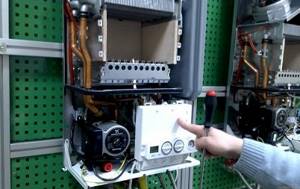
Burner not adjusted correctly
The reason that the gas boiler does not reach temperature may be improper regulation of the burner flame. In this case, the temperature usually does not exceed 50-60ºC. In this case, it is necessary to increase the flame strength using the burner regulator. To do this you will have to remove the boiler body.
Note! When adjusting the flame, you should monitor the main settings indications. You may need to increase or decrease the flame further.
Low coolant velocity
The reason for the lack of heat may be a decrease in the speed of movement of the coolant through the system. This may happen if:
- Leaks in radiators or pipes. You should first check all connections and joints. If a leak is found, it must be sealed. After this, coolant should be added to the system.
- Incorrect pump adjustment. Circulation pumps usually have a speed controller. To speed up the movement of the coolant, switch the pump to higher speed.
- Closed shut-off valves. You need to make sure that all radiators have a good supply of water.
- Airing the system. Trapped air delays the circulation of coolant in the system. To eliminate it, Mayevsky taps are used, they are opened and excess air is released from the batteries.
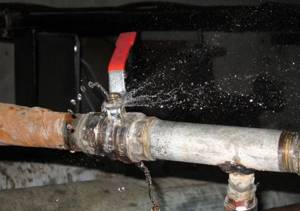
Automation malfunctions
Faulty temperature sensors can lead to insufficient heating of the boiler. One of them may send a false signal about the set temperature indicator, as a result of which the boiler will turn off.
